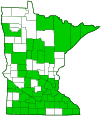partridge pea
(Chamaecrista fasciculata var. fasciculata)
Conservation • Wetland • Description • Habitat • Ecology • Use • Distribution • Taxonomy
Description |
Partridge pea is a 4″ to 36″ tall, erect, annual forb that rises on one or a few stems from a taproot. The stems are erect or ascending, slender, and light green at first, becoming reddish brown as the season progresses. They are occasionally branched at or above the middle. They are sparsely to moderately covered with short, spreading or curled, upward-pointing hairs. The stems are weak and taller (longer stemmed) plants often sprawl. The leaves are alternate and 2″ to 3½″ long. They are sensitive to touch, and will fold longitudinally when disturbed. They are on 2″ to 3⅛″ long leaf stalks (petioles). Near the middle of the petiole, on the upper surface, there is a 1 ⁄32″to 1⁄16″ in diameter, usually stalked, saucer-shaped gland. The gland is a nectary and attracts insects. At the base of the petiole there is a pair of small, green, leaf-like appendages (stipules). The stipules are narrowly lance triangular, asymmetrical, ¼″ to ⅝″ long, and 1 ⁄32″to 1⁄16″ wide. They are long tapered at the tip and have several prominent, parallel veins. They remain on the plant throughout the growing season. The leaf blades are pinnately divided into 5 to 18 pairs of leaflets. The leaflets are narrowly oblong to oblong, ⅜″ to ¾″ long, and 1⁄16″ to 3 ⁄16″wide. They are stalkless, asymmetrical at the base, and taper abruptly to a sharp or blunt point at the tip. A minute, stiff, hair-like extension of the midvein (mucro) projects from the tip. The upper surface is green and hairless. The lower surface is green, hairless, and somewhat covered with a whitish, waxy coating (glaucous). The margins are untoothed but have a fringe of short, spreading hairs. The inflorescence is a cluster of 1 to 3 flowers rising from the stem near but not in the leaf axils. Normally, only 1 flower is open at a time. Each flower is on a ⅜″ to ⅝″ long stalk. The flowers are 1″ to 1¼″ in diameter and asymmetrical in appearance. There are 5 sepals, 5 petals, and 10 stamens, and 1 style. The sepals are green, linear to lance-shaped, sharply pointed, ⅜″ to ½″ long, and 1 ⁄16″ to ⅛″ wide. The petals are yellow, reddish at the base, broadly egg-shaped, unequal in size, narrowed at the base (clawed), ⅝″ to ¾″ long, and 5 ⁄16″to 11⁄16″ wide. One of the lateral petals curves around the stamens. There are 9 short stamens grouped on one side of the style and 1 large stamen on the opposite side. The anthers are purple and ¼″ to ⅜″ long. The style is greenish-white, about ⅜″ long, and curved. The fruit is a flattened, 1¼″ to 2⅜″ long, 3 ⁄16″to ¼″ wide seed pod with 4 to 20 seeds. The seed pods are straight, not twisted. They are green and hairy at first, becoming dark brown and hairless at maturity. When mature the seed pods fling the seeds a good distance from the plant. |
Height |
4″ to 36″ |
Flower Color |
Yellow |
Similar Species |
Habitat |
Dry to moderate moisture. Prairies, savannas, meadows, railroads, roadsides, open disturbed areas. Full sun. |
Ecology |
Flowering |
July to September |
Pests and Diseases |
|
Use |
|
Distribution |
||
|
Sources Biodiversity occurrence data published by: Minnesota Biodiversity Atlas (accessed through the Minnesota Biodiversity Atlas Portal, bellatlas.umn.edu, 8/17/2025). |
|
| 8/17/2025 | ||
Nativity |
||
Native |
||
Occurrence |
||
|
||
Taxonomy |
|
Kingdom |
|
Subkingdom |
Pteridobiotina |
Phylum |
Tracheophyta (Vascular Plants) |
Class |
|
Order |
Fabales (Legumes, Milkworts, and Allies) |
Family |
Fabaceae (Legumes) |
Subfamily |
Caesalpinioideae (peacock flower) |
Tribe |
Cassieae |
Subtribe |
Cassiinae |
Genus |
Chamaecrista (sensitive and partridge peas) |
Section |
Chamaecrista |
Species |
Chamaecrista fasciculata (partridge pea) |
Subordinate Taxa |
|
common partridge pea (Chamaecrista fasciculata var. fasciculata) tidal-marsh partridge pea (Chamaecrista fasciculata var. macrosperma) |
|
Synonyms |
|
Cassia brachiata Cassia chamaecrista Cassia fasciculata Cassia fasciculata var. brachiata Cassia fasciculata var. depressa Cassia fasciculata var. ferrisiae Cassia fasciculata var. puberula Cassia fasciculata var. robusta Cassia fasciculata var. rostrata Cassia fasciculata var. tracyi Cassia mississippiensis Cassia robusta Cassia rostrata Chamaecrista brachiata Chamaecrista depressa Chamaecrista littoralis Chamaecrista mississippiensis Chamaecrista robusta Chamaecrista rostrata Chamaecrista tracyi |
|
Common Names |
|
golden cassia locust-weed partridge-pea partridge pea prairie senna showy partridge pea sleeping-plant sleepingplant |
|
Glossary
Axil
The upper angle where a branch, stem, leaf stalk, or vein diverges.
Claw
A stalk-like narrowed base of some petals and sepals.
Glaucous
Pale green or bluish gray due to a whitish, powdery or waxy film, as on a plum or a grape.
Mucronate
Tipped with a short, sharp, abrupt point.
Nectary
A tissue or organ which produces nectar, usually at or near the base of the inside of a flower.
Petiole
On plants: The stalk of a leaf blade or a compound leaf that attaches it to the stem. On ants and wasps: The constricted first one or two segments of the rear part of the body.
Pinnate
On a compound leaf, having the leaflets arranged on opposite sides of a common stalk. On a bryophyte, having branches evenly arranged on opposite sides of a stem.
Sepal
An outer floral leaf, usually green but sometimes colored, at the base of a flower.
Visitor Photos |
||
Share your photo of this plant. |
||
This button not working for you? |
||
Luciearl |
||
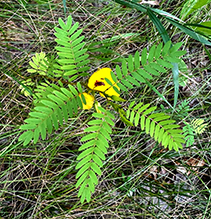 |
 |
|
Growing in nearby woodland area. |
||
Nancy Falkum |
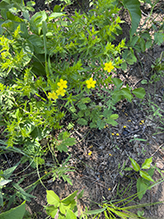 |
Hoary puccoon Lithospermum canescens w/ Partridge pea At TNC KWD Cox Unit |
MinnesotaSeasons.com Photos |
||
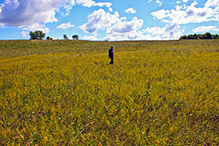 |
||
Habitat |
|
|
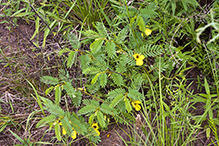 |
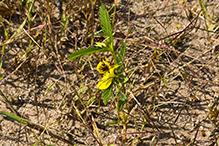 |
|
Plant |
Plant |
|
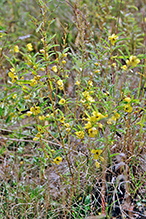 |
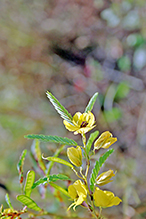 |
|
Plant |
Inflorescence |
|
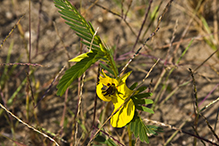 |
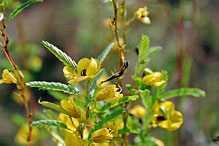 |
|
Inflorescence |
Inflorescence |
|
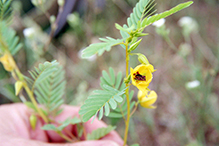 |
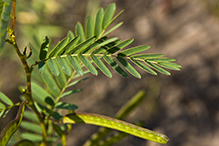 |
|
Leaves |
Leaves |
|
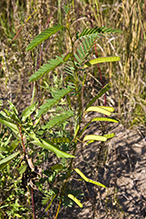 |
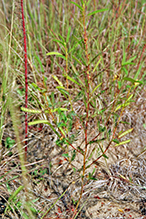 |
|
Infructescence |
Infructescence |
|
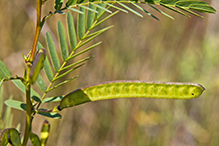 |
||
Fruit |
|

Slideshows |
|

Visitor Videos |
||
Share your video of this plant. |
||
This button not working for you? |
||
|
Other Videos |
||
Nature in a Minute, Episode 7 - Partridge Pea |
About
Uploaded on Sep 19, 2011 A look at Partridge Pea, a wildflower that attracts quail, turkeys, and lots of butterflies. Check out the Cloudless Sulphur caterpillar in the video, too. |
Chamaecrista fasciculata Partridge Pea |
About
Published on Sep 5, 2012 A regional native member of the legume family Fabaceae. |
Partridge Pea - Native pollinator plant |
About
Uploaded on Jun 1, 2010 Partridge Pea (Chamaecrista fasciculata) Native wildflower found through out the South east of N. America. Butterflies and pollinators love it. It is self-seeding, pretty and drought-tolerant. A great plant for yards. http://www.pool2pond.blogspot.com |

Visitor Sightings |
||
Report a sighting of this plant. |
||
This button not working for you? |
||
| Luciearl 8/17/2025 |
Location: Lake Shore |
 |
| Nancy Falkum 6/26/2022 |
Location: Weaver Dunes Preserve, Cox Unit Hoary puccoon Lithospermum canescens w/ Partridge pea At TNC KWD Cox Unit |
 |
| Luciearl 8/14/2022 |
Location: Lake Shore Growing in nearby woodland area. |
 |
MinnesotaSeasons.com Sightings |
||

|
Created: 9/18/2004 Last Updated: © MinnesotaSeasons.com. All rights reserved. |
